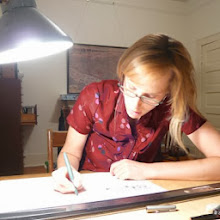 |
| click enlarge |
At the conference, I learned that these images of Camilo Jose Vergara, Kevin Bauman and Marchand & Meffre which piqued my curiosity and drew me to Detroit were "ruin porn" - and I am guilty. The photos I made of Detroit's downtown depict an architecture of soaring confidence and aspiration - empty and available, juxtapositions between architectural decay and grandeur, proliferation of parking lots and the marks of human expression/exasperation - buildings as canvas.
This was the largest attendance of an SAH conference in its over 60-year history. No big deal, though. Every conference that comes to Detroit lately notes the same phenomenon. People are curious about what's going in Detroit. I attended all of the paper sessions treating various aspects of Detroit's history and a dynamic session on "Shrinking Cities." I also attended a roundtable discussion to learn about local city-wide initiatives such as LEAP, spearheaded by community organizer/CEO Maggie DeSantis, focused on improving quality of life in the severely depleted Lower Eastside. Passion and tension were high as Detroit's movers and shakers explained the hopes and challenges of their work and the conference attendees posed questions, generally supportive. One attendee, in shaking voice, asked where all the people were in the plans presented by the panel, including DeSantis, insinuating a lack of humane planning. This woman was exported from Detroit forty years ago because there was no work for an educated woman in Detroit. She found a place in Chicago, but Chicago didn't need her. Don't export any more people, she said. DeSantis blithely responded that she was an educated woman (no doubt) and she stayed. Detroit is a proving ground and can be an incubator for innovative plans for re-imagining this formerly industrial city - but Detroit is not a clean slate where one can do anything. Detroit has a deep history, real dedicated residents with real needs; new-comers thinking outside the box are welcome but they are reminded to be humane and context-sensitive.
Preservation as a tool for healing and re-imagining Detroit threaded through almost every discussion and brought me to some critical questions about the ways preservation might do more than conserve building resources, who was responsible or capable of preserving Detroit's buildings and landscapes, the many scales at which preservation can be deployed and which are most critical, the role of preservation and its dismissal in the city's history. I wondered why, until the past decade perhaps, preservation had little relevance here. It seemed more than other cities, buildings were demolished, easily devalued and thrown away. One conference presenter explained the mentality of Fordism which was constantly striving toward the next innovation and discarding the last, the outmoded translated to the city population's regard fro building as [disposable] resources. Demolishing itself was a sign of progress - either to make way for the next big thing or, in post-war decline, to remove an outmoded scar in the cityscape. An "architecture of optimism." Another presenter, a Detroit activist, educated us on the thick memory of racial division and oppression in Detroit. He explained that these magnificent edifices we might mourn over as they crumble were not mourned by Detroit's black citizens because these were symbols of their dismissal, where they were denied entry or full civic participation.



























2 comments:
You never cease to amaze me. I'm so impressed with your creativity but I'm even more impressed with your intelligence and passion to understand and help people of all nations and cultures. You are doing such great things with your life and career! Miss you.
Wow! Detroit! I've always wanted to visit. All I see now are pictures of abandoned houses. I'm glad you get to explore.
Post a Comment